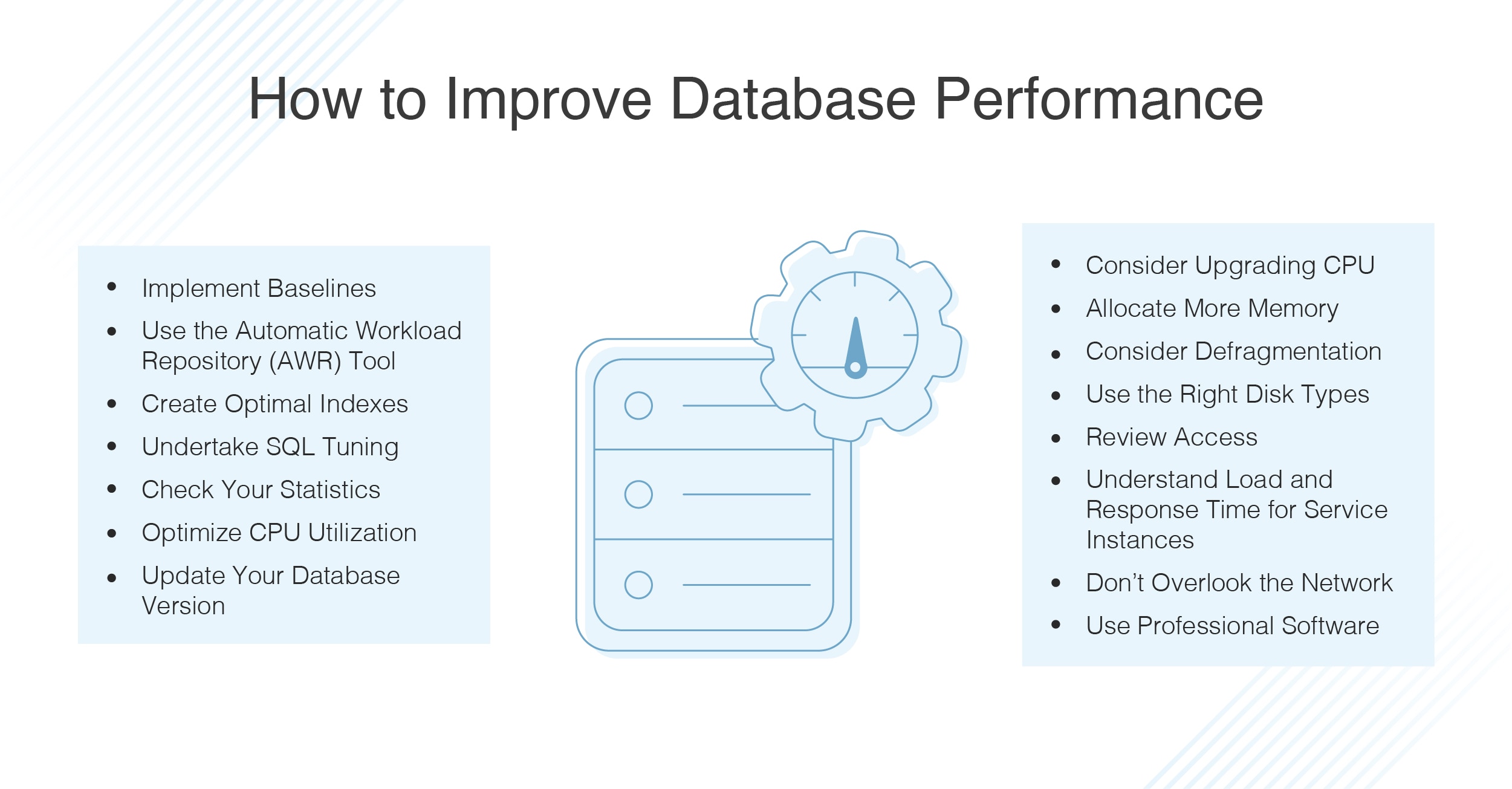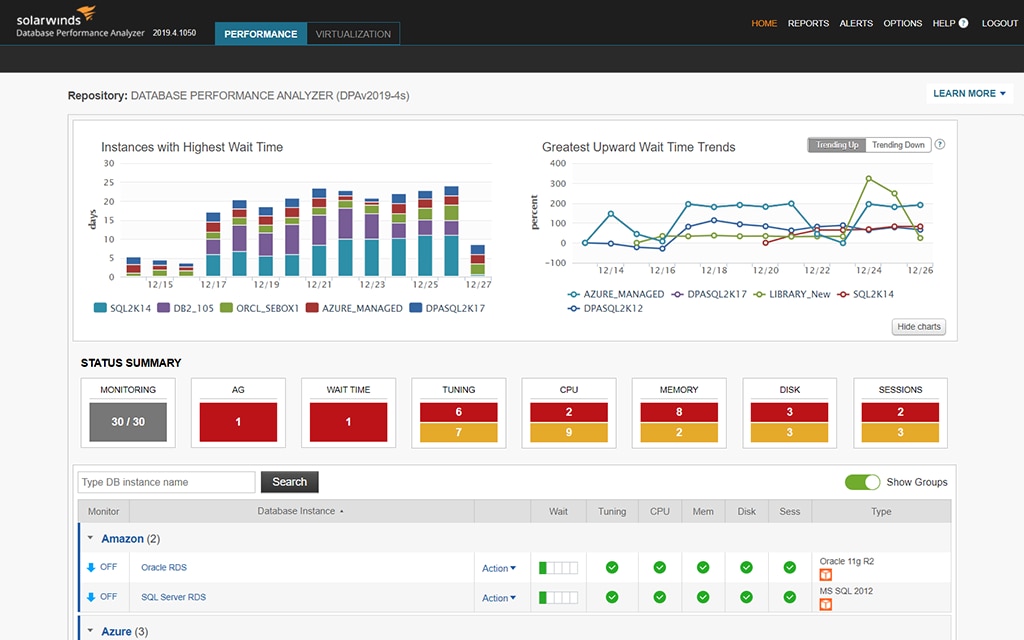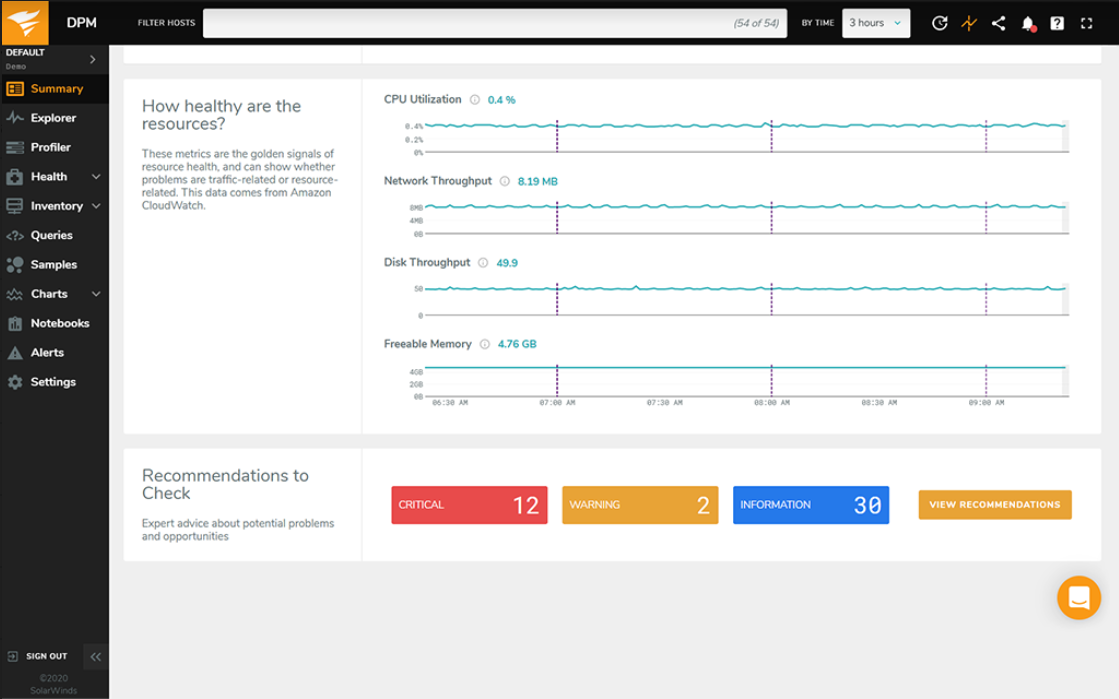As a database administrator, you’re likely familiar with the frustration of receiving a flood of calls regarding slow online performance. If systems are unresponsive or lagging, the best way to improve database performance is by undertaking optimization and tuning activities. Performance tuning can help you identify bottlenecks and ensure your infrastructure can manage increased loads.

If you need to improve database performance, there are several things you can do to prevent and rectify possible issues. The following tuning tips can help you optimize your database performance and maintain a fully operational environment. This guide includes performance improvement database tips for MySQL, SQL Server, and Oracle.
The most effective way of improving database performance is by implementing the right database performance analysis and monitoring tools. SolarWinds® Database Performance Analyzer (DPA) and Database Performance Monitor (DPM) can help you improve MySQL performance, Oracle database performance, and SQL Server performance. These tools are highly versatile, advanced, and user friendly.
- How to Improve Database Performance
- How to Improve Database Performance With DPA and DPM
- Getting Started With Performance Improvement Database Tips
How to Improve Database Performance
1. Implement Baselines
Maintaining an established performance baseline is a key aspect of effective tuning because it gives you a reference point for when a problem occurs. Baselines help you identify peak usage periods quickly and easily, allowing you to set performance targets and gain an accurate understanding of system capabilities. Consistently measuring existing performance will provide exact expectations of how your database should be performing. This is helpful when tuning bottlenecks that are likely to arise in the future.
2. Use the Automatic Workload Repository (AWR) Tool
If you hope to improve Oracle database performance, make sure you’re using the automatic workload repository (AWR) function as an Oracle monitoring tool. AWR collects, processes, and maintains performance statistics, giving you daily insight into database health. This allows you to then use the Automatic Database Diagnostic Monitor (ADDM) provided by Oracle to gain actionable insights into AWR statistics. By using both AWR and ADDM in combination, you can significantly improve Oracle database performance, enhance your tuning abilities, and save time and money in the long term.
3. Create Optimal Indexes
When done properly, indexing can help you optimize your query execution duration and improve database performance. Indexes implement a data structure to help you stay organized and make finding data easier. Indexing speeds up the process of retrieving data, increasing efficiency and saving you time and effort.
4. Undertake SQL Tuning
SQL is widely considered to be a message language because when a query is sent, data is returned. However, client solutions often create inefficient SQL statements, which can have a negative effect on the performance of your database. When undertaking performance tuning, carefully consider SQL that consumes significant system resources. If you’re trying to improve Oracle database performance, you can leverage Oracle SQL tools, like the Query Optimizer. By keeping an eye on your SQL processing engine, you can enhance performance tuning, ensuring your SQL is working as it should be.
If you’re looking to improve SQL Server performance or improve MySQL performance, it’s still useful to leverage a query optimizer. In most cases, performance problems are caused by poorly written SQL queries. When you attempt to optimize those queries, you’ll encounter some obstacles. This might include choosing between using IN or EXISTS and deciding whether to write a join or a subquery. Query optimizers are cost-effective alternative consulting services that can speed up SQL queries significantly. Many query optimizers even explain their recommendations, helping you improve your query optimization skills.
5. Check Your Statistics
When performance tuning for SQL Server, MySQL, or Oracle, checking on your statistics regularly is of critical importance. You should always have access to a full compilation of database, operating system, and application metrics because there’s much more to performance tuning than simply rectifying performance problems. Performance tuning is a crucial maintenance component and should be performed throughout the lifecycle of an application. To achieve this, you should continually check your statistics and refine the process of gathering and presenting them, to boost efficiency as your company changes and grows.
The symptoms of performance problems are usually identifiable in the data, which is why it’s fundamental to not overlook the stats—they play a key role in your performance tuning efficiency.
6. Optimize CPU Utilization
If your database’s diagnostic features can’t manage a specific problem, you may need to undertake manual performance tuning processes. When investigating problems of this nature, ensure your CPU is being utilized correctly. Start by checking CPU utilization in the user space. This will verify whether there are any non-database tasks currently consuming CPU, which will limit the amount of shared CPU resources. Once CPU usage has been finalized, it becomes much easier to rectify performance issues. This can also help clarify your decision making.
7. Update Your Database Version
Whether you’re trying to improve MySQL, Oracle, or SQL Server database performance, staying up to date is crucial. A query may perform better in older versions than in new ones, but new versions tend to perform better as a general rule. As such, an up-to-date system is likely to experience more stable performance.
8. Consider Upgrading CPU
As this guide has already mentioned, the better your CPU the quicker and more efficient your database performance will be. For this reason, if your database isn’t performing as it should be, you should consider upgrading to a higher-class CPU unit. If your CPU is more powerful, it’ll be under less strain when tasked with multiple requests and applications. Moreover, when assessing your CPU performance, you must keep track of all performance aspects. This should include CPU ready times, which reveal the times your system tried to use the CPU but couldn’t because the CPU’s resources were otherwise occupied.
9. Allocate More Memory
Like a lack of CPU, a lack of memory can also have an impact on the efficiency of your database. If there isn’t sufficient memory available, the database may not be able to perform what’s being asked of it, resulting in database performance decline. Having more memory available to your database will boost both performance and overall system efficiency.
To determine if you need to allocate more memory, review how many page faults your system has. If the number of faults is high (i.e., in the thousands), your hosts are running low on available memory space. As such, when trying to improve database performance, you should consider how much memory you have in total and the number of page faults. This process will give you insight into whether allocating additional memory would improve efficiency.
10. Consider Defragmentation
If your database is running slowly, data defragmentation might be an effective route to take. When lots of records are written to the database and time passes, the records can become fragmented in internal data files and on the disk itself. Disk defragmentation allows relevant data to be grouped together, which speeds up I/O related operations. This has a direct effect on database performance and query performance. It’s also important to ensure you have enough disk space when running your database. If you want to improve database performance significantly, you should combine disk defragmentation with ensuring plenty of disk space is available.
11. Use the Right Disk Types
Retrieving the results from just one query can potentially require millions of I/O operations from the disk. The amount of operations required directly depends on the amount of data the query needs to access for processing and on the amount of data returned from the query. As such, the type of disks in your server can have a notable impact on the performance of your queries. Using SSD disks can improve query performance and database performance.
12. Review Access
Once you’re sure your database hardware is healthy, you should review which applications are accessing your database. If one of your services or applications is experiencing poor performance, be sure not to make assumptions regarding which application is responsible for the performance issues. Inferior database performance can be caused or impacted by several factors. The database as a whole might be infected, or a single client might be experiencing poor performance.
If all your database’s clients are suffering from poor performance, you may want to confirm your host is healthy. In this instance, your hardware is probably struggling to cope with the load. If a single service is experiencing poor response times, drill down into that service’s metrics to determine what might be causing the problem.
13. Understand Load and Response Time for Service Instances
If an individual service is experiencing poor database performance, take a closer look at how the service is communicating with the database. You should investigate the following:
- Which queries are executed?
- How many rows do queries return?
- How often are the queries executed (per request)?
- If you are running multiple instances of a single service, are all instances impacted or just single ones?
- Is there any reason why a single query should be executed more than once per request?
Keep in mind, issues that materialize at the database level may be rooted elsewhere, and the source of the issue may relate to how the database is being accessed. Once you consider how often queries are called per request, you may find you can reduce the number of database queries by enhancing the database cache of your service. If you find a good reason for a single query to be executing more than once per request, it could be advantageous to apply smart caching strategies. These strategies can significantly boost performance, in some cases.
14. Don’t Overlook the Network
It’s easy to overlook the physical constraints on virtualized infrastructure, but they play an important role in performance. Unfortunately, cables, routers, and other hardware can fail. If issues suddenly arise after months of operating without any problems, then your infrastructure may be experiencing a physical issue. To confirm this, you should check your routers, cables, and network interfaces. You should check these components at the first sign of an issue, so you stand the best chance of fixing it before it impacts your business.
Often, over-stressed or overloaded processes drop packets because their resources are depleted. If your network issue isn’t caused by a hardware problem, process-level visibility can be a useful way of identifying a failing component.
How to Improve Database Performance With DPA and DPM
Most of the tips listed in this article can be used to improve MySQL performance, Oracle database performance, and SQL Server performance. The right professional software can help you manage the implementation of these practices on an ongoing basis, enhancing database performance without overwhelming you with labor. Comprehensive professional tools, like SolarWinds DPA and DPM, monitor key performance metrics and give you access to a range of diagnostic capabilities. With the right database monitoring solution, you gain insight into your database and can leverage optimization utilities to enhance performance.
SolarWinds Database Performance Analyzer (DPA)
SolarWinds DPA is a cross-platform database performance tuning and optimization tool with support for PostgreSQL, MySQL, Amazon Aurora, IBM DB2, SAP ASE, MariaDB, Oracle, Microsoft SQL Server, and Azure SQL databases. DPA uses a response time analysis approach to tuning SQL and query performance, empowering you to deliver noticeable results. Response time analysis, also called wait time analysis, analyzes the actual time taken to complete a desired operation, as opposed to making estimates based on server health.

This database management software helps align resource provisioning with database performance, allowing you to be more prescriptive about hardware recommendations. DPA features a SQL query analyzer, which can be used to identify how resource provisioning is affecting database response times. These capabilities also give developers a unique perspective on VMware infrastructure and how it affects database performance.
Another useful DPA feature is the historical repository, which highlights trends and anomalies that are easy candidates for SQL tuning. DPA uses historical data to help you identify opportunities for current improvements, providing a wide range of data from five seconds ago to five years ago. This insight helps you resolve performance issues quickly.
DPA offers an impressive range of advanced features, including anomaly detection powered by machine learning. It provides real-time insights, expert advice with index and query tuning advisors, and the ability to monitor multiple active sessions simultaneously. With multi-dimensional performance analysis capable of quickly isolating the root cause of complex issues, and integration support for the SolarWinds PerfStack™ and AppStack™ dashboards, DPA is a powerful and versatile tool.
DPA is also user-friendly, with a dynamic and intuitive user interface. It offers cost-efficiency and scalability for small and large companies alike and is suitable for database administrators with minimal experience. You can access a 14-day free trial of DPA here.
SolarWinds Database Performance Monitor (DPM)
While SolarWinds DPA offers a greater focus on analysis, DPM provides in-depth monitoring capabilities. This tool gives you an efficient and convenient way of monitoring your database’s performance in real-time, on a day-to-day basis. With DPM, check-ups are simple, and you have access to expert guidance, filling a potentially critical gap in your monitoring stack.
DPA delivers 24/7 real-time monitoring, helping you attain your KPI goals for reduced failed deploys, availability, deploy frequency, MTTD, MTTR, lead time for changes, and much more. This tool sends you instant recommendations regarding server configuration changes and underperforming queries. DPM is ideal for application development and is popular among DevOps teams as a means of keeping databases healthy.

DPA is also a flexible tool, allowing you to build custom dashboards, so you can keep your priorities front and center. The dashboards feature health summaries for databases and systems, letting you track metrics and watch for trends. They allow you to explore performance outliers, manage resource capacity, and much more.
DPM helps you lower change fail rates, recover faster, and share what you learn across your team with DPM Notebooks. This utility allows you to create and share post-mortem documentation with text, code snippets, links, and images. With DPM, you can gain an in-depth understanding of how queries affect your database by correlating query response or behavior to system metrics. This tool also allows you to isolate unusual behavior and potential contributing factors, as well as explore query details and performance (including execution plans, samples, and more).
This SaaS platform features a user-friendly web-based user interface, making DPM suitable for less experienced users. Like DPA, DPM offers cross-platform support including MySQL, MongoDB, PostgreSQL, Redis, and Amazon Aurora. A 14-day free trial of DPM is available.
Getting Started With Performance Improvement Database Tips
The most effective way to implement the tips mentioned in this guide without overwhelming your team with work is to leverage professional software. While there are plenty of database monitoring and analysis tools available, SolarWinds DPA and DPM come highly recommended. These tools are scalable, user-friendly, and offer a suitable range of utilities designed to allow you to significantly improve your database performance with minimal effort.

